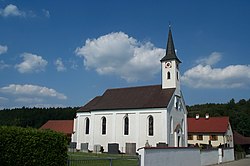St. Nicholas (Franconia)
The Roman Catholic Expositurkirche St. Nikolaus in Franconia near Laberweinting is a neo-Gothic hall church that was built in 1869. The church is a monument of the Bavarian State Office for Monument Preservation with the number D-2-78-144-9.
location
The village of Franconia with the Expositurkirche St. Nikolaus is idyllically situated in the valley of the Altbach between Neuhofen , Haader and Hadersbach . Fragments and black spots in the ground suggest that the village was formerly higher up in a north-westerly direction below Reuth and probably burned down in the Thirty Years' War .
history
In 1865 the Franconian Expositur was set up, which at that time still belonged to the parish of Martinsbuch . The cemetery was still in Martinsbuch for a long time, to which a dead path led through the forest. Today the village and branch belong to the municipality and parish of Laberweinting . The church is surrounded by a separate church for the villages of Franken and Reuth. In 1869 the church of St. Nicholas was built in neo-Gothic style as a successor to a chapel, from which some figures are likely to come.
description
architecture
Exterior construction
As an exception, the house of God faces north and not, as usual, eastward. The nave has three axes with ogival windows. The retracted choir closes in five sides of an octagon. The recessed, square tower appears above the south gable as a roof turret with a cranked pointed helmet. In the small bell house under the clock face there are three bells that call for church services and the Angelus prayer . There is another small bell in the rectory, which may have come from the previous building, but the sound does not match the ringing. The bells survived the chaos of war unscathed and were not, as in many other churches, melted down as a material essential to the war effort. You enter the church via an arched entrance on the south side in the basement of the tower. Above the portal, a small statuette of St. Joseph .
inner space
The choir is covered with a star-shaped net vault . The grooved ribs arise from semicircular pointed consoles and unite in the crown of the vault on round keystones . Colorful glass windows with motifs of St. Nicholas and St. Josef bathe the choir in subdued light. The ship is flat covered with a wooden ceiling. The uniform, neo-Gothic interior dates from the time the church was built.
Furnishing
Neo-Gothic furnishings from the time the church was built with three altars. South gallery above the entrance. The fields of the straight gallery parapet are enlivened with Gothic ornaments. The confessional is located on the gallery stairs .
Altars
The altars are crowned with pinnacles , gables, turrets and finials. The neo-Gothic high altar is divided into three shrines . The cross stands above the tabernacle , flanked by two angels; in the left shrine the figure of the church patron St. Nicholas of Myrha with three apples on a book. In the right shrine you can see the figure of St. Boniface with his attribute of the ax. The side altars of the Sacred Heart of Jesus and the Sacred Heart of Mary are similar to the high altar and have pinnacles and lateral flower ornaments in openwork carving. The two-part communion bench with three-pass ornaments is still preserved under the choir arch .
Baptismal font
At the right side altar is the baptismal font made of light sandstone . The profiled shaft merges from the square base into an octagon, which is followed by the octagonal bowl decorated with ornaments . The cover consists of an octagonal wooden pyramid with carved Gothic ornaments and a finial.
characters
The body of the cross, which hangs in the tapering choir arch, was probably made by the same sculptor as the figure of St. Sebastian from the 19th century. Left in the choir figure of St. Brother Konrad . The figure of St. Wendelin is no longer there. A replica of an Altötting Madonna in a rosary hangs on the west wall of the nave . The figure from the 19th century was unfortunately lost and was re-donated by a family from Franconia.
pulpit
The hexagonal pulpit is on the east wall of the nave. The fields and the stairs are decorated with three- and four-pass elements and plenty of tendrils . The sound cover repeats the basic shape of the pulpit and has a high structure with pinnacles and finials .
organ
On the spacious loft which is in the width of the entrant tower single-manual organ with three times parted prospectus in historical frame construction with three Manual - registers and pedal . Before the organ case is the free-standing gaming table . The organ comes from the Regensburg organ builder August Hartmann . It replaces the previous organ by Ludwig Edenhofer .
|
|
||||||||||||||||||
- Coupling : I / P
priest
From 1953 to 1985 the legendary Expositus Pater Alois Späth worked in Franconia . The honorary citizen of the parish Laberweinting was a member of the Mission Society of St. Joseph von Mill Hill and played the role of a priest in the film "The 42 Saints" by Georg Lohmeier .
See also
Web links
Individual evidence
- ↑ a b c d Franken Sankt Nikolaus, interview with the church caretaker Erich Sicheneder in October 2010.
- ↑ a b Die Kunstdenkmäler von Niederbayern, XXV District Office Mallersdorf from 1936, page 43.
- ^ Franken - Sankt Nikolaus, description of the church by Richard Stadler .
- ^ Franconia - Sankt Nikolaus, pictures on Richard Stadler's private website .
- ^ Organ disposition with the kind support of Stefanie Huber.
Coordinates: 48 ° 46 ′ 9.3 ″ N , 12 ° 22 ′ 31.5 ″ E








